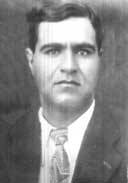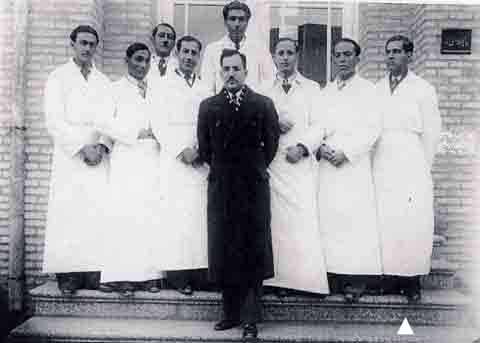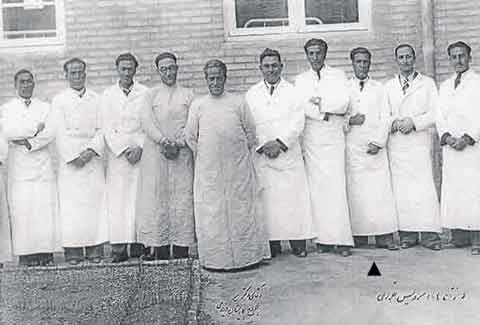|
Series:
Prominent Zarathushtis
Source:
Author:
Farshidi,Dr. Bahram
Subtopics:
Reference:
Related Articles:
Related Links:
|
[i]
Dr. Farshidi was asked to
write a brief biography of his beloved maternal uncle, the late and long-
remembered Dr. Mehraban Shahriari. With permission from his noble son, Dr.
Darioush Shahriari, and assistance from relatives and others familiar with
his life and times, Bahram embarked on this effort.

 |
|
Dr. Mehraban Shahriari |
Mehraban Shahriari's journey through life had three distinct phases.
The Formative Years:
The first phase of his life, which undoubtedly influenced his character
development and choice of future path in life, was his childhood through his
graduation from high school. It was during this period that his experiences
living in society riddled with injustice, discrimination and man-conceived
social barriers against a backdrop of semi-feudal socio-economic reality
touched his consciousness and influenced him very profoundly. All these
factors resulted in his maturing into a human being with an unselfish desire
to lend a helping hand to all his fellow man in need of social justices.
For the benefit of the readers, some background information relative to the
socio-economic realities of the 1500+ strong Zoroastrian community of
Kerman, Iran of the early 20th century would be appropriate. [ii]
During the first half of the twentieth century, Zoroastrians in Kerman were
mostly farmers, with a few merchants, businessmen or government bureaucrats
in their ranks. The social atmosphere of the city dominated by Islamic
religious-based thinking,
created
difficult conditions for minorities. For instance, a Zarathushtrian was not
allowed to touch any edible item at a store before purchasing the item, or
they were not allowed to leave their homes on rainy days, as the Moslems
believed the rain drops washing off the minorities would defile the earth.
It was under such socio-economic conditions and mindsets that
Dr. Mehraban
Shahriari was born in a Zarathushtrian family in
Kerman of 1909. While
growing up in Kerman, as a student in elementary and high school and then as
a teacher for 2-3 years, he observed and assimilated the pain and suffering
of all members of the community resulting from lack of medical care as well
as poor socio-economic conditions driven by injustice and prejudice. It was
hard to find a family that had not lost a child to a simple infection or to
find a child bearing mother who had not lost a baby during childbirth. His
sensitive nature must have been profoundly touched by witnessing such
conditions. He was also inspired by the accomplishments of his mother’s
cousin, Adorbad Kermani, MD who had graduated from a British medical school
and was practicing ophthalmology in India. Mehraban Shahriari set his mind
on pursuing his education in medicine and was accepted at Tehran University
School of Medicine that had been established just a few years earlier. [iii]
|
 |
|
Mehraban
Shahrian (right) at Medical school; Professor Jahanshah Saleh at the
center |
Professional
Growth:
The second phase of Dr.Mehraban Shahriari's
journey through life was shaped not only by his medical school education but
also by the opportunity to collaborate closely with scientific and
intellectual elites of Tehran such as Dr. Jehanshah Saleh, [iv]
Dr. Mir,[v]
Professor Shams[vi]
and
Professor Pour-Davoud,[vii]
whose friendships lasted long after completion of medical school. [viii]
Dr. Shahriari was amongst the first group of medical doctors to graduate
from
Tehran University Medical School in 1939.[ix]
Upon graduation, Mehraban Shahriari returned to his birth city of Kerman.
Dr. Saleh’s request and urging that he stay in Tehran and teach at the
Medical School could not keep him from his desire to return to his native
town and to be an agent of change. This period of his life, not only
empowered him with the knowledge and skills of a physician but also
solidified his determination and dedication while strengthening his moral
character to embark on his personal quest to serve his community on a scale
that had no precedence in the preceding centuries and that has not been
witnessed in Kerman to the time of this publication.
Unprecended Service:
The third and final phase of his journey through life began almost
immediately after his return to his birth place, as the first returning
native son who had studied modern medicine at an Iranian university.
Dedicated to the cause of helping people with his newly acquired
professional knowledge and skills Dr. Shahriari set on a life of self-less
service to his fellow man.
In the short span of
time before his premature death, Dr. Shahriari’s accomplishments left a
legacy of unsurpassed humanitarian and professional dedication to the
welfare of all humans that he
reached. His
memory continues to be cherished half a century after his death.
The legacy of Dr. Shahriari’s unselfish caring for others has been an
inspiration for three generations in Kerman where countless number of
people were touched by him. There are so many examples of the lives he
saved from infections and other illnesses, of how he would leave money under
the floor mat of the poor patients he visited at their homes so they could
afford to buy food and medicine. Examples abound of how he would routinely
make calls at the home of the sick people he had come to hear about without
being called for, so he could help them get well. He was an angel of change
who broke the social and community barriers by caring for all people
regardless of their creed, religion, social status or ability to pay. He was
loved and respected by all who knew or heard of him. His service to the
citizens of Kerman when an epidemic broke out in the aftermath of WWI was
exemplary.
His dedication to the cause of helping sick people was fueled by his firm
belief in compassion for fellow humans and his professional adherence to the
“Hippocratic” oath he had taken. Dr. Shahriari was married in 1945 to Parvin
Shahriari, and his only child, a son, Darioush, was born in 1946.
Ironically, Dr. Mehraban
Shahriari
passed away in 1948 of complications of
appendicitis three days after he underwent surgery at the hands of Dr. Wild,
a British surgeon practicing in Kerman. His friends in the capital, high
ranking officials including Dr. Saleh, had dispatched a governmental
airplane[x]
to Kerman
to transport him to Tehran for treatment but it was too late.
His son, Darioush, was sent to Germany at age 9 carrying the spiritual
support and legacy of his father with him, and became a physician and a
cardiopulmonary specialist in his own right.[xi]
His Legacy:
The legacy of Dr. Mehraban
Shahriari
goes beyond that of a caring physician. He helped transform a society ridden
by religious bigotry and intolerance into a more compassionate and unified
society and gained unprecedented respect and love for his fellow
Zoroastrians from the Moslem majority in Kerman. He helped the various
communities to open their hearts to each other, and influenced their
thinking as human beings. When the news of his demise spread, the entire
city shut down in mourning and the Moslems claiming him as one of their own
demanded to bury him according to Islamic rites and in the Moslem cemetery.
Reluctantly, they accepted the wishes of the family that Dr. Mehraban
Shahriari
be buried in the Zoroastrian
cemetery. It seems as though the entire city turned up to pay their last
respects to the city’s favorite son and home grown hero.
Dr.
Mehraban Shahriari, the self-less care giver and the social agent of change,
was instrumental in opening people’s mind to a higher level of humanity and
human caring than was known before him. The following short stories
demonstrate Dr. Shahriari’s influence on the people of his time and
subsequent generations.
-
On one occasion many years after Dr. Shahriari
had departed this life, the author’s older brother Dr.
Ardeshir Farshidi came to discover to his pleasant surprise the level of
admiration, respect and inspiration instilled in others by his late uncle.
After completion of his medical schooling in
Iran,
Dr. Ardeshir Farshidi was slated to start his national service (Sepah
Behdasht), [xii]
when he was contacted by the Deputy Secretary of
Health’s Office in regards to local health policies. Upon meeting
Ardeshir, the Deputy Secretary of Health, Dr. Dadgar, manifested a
recognition of the family relationship between Dr. Farshidi and the late
Dr. Shahriari. Dr. Dadgar had previously spent many years practicing
medicine in
Kerman. Thus he was quick to recall Dr. Shahriari’s compassion, kindness
and generosity demonstrated through his extensive humanitarian work within
the community distinguishing him as a true leader and role model for an
entire generation.
-
This author recalls when he was in the first year
of medical school at
Tehran University, a
professor asked the freshman class to state their reasons for choosing to
study Medicine. A female student who later became an ophthalmologist,
explained that her father, a native of
Kerman
had told her the life story of the legendary physician of Kerman, and had
encouraged her to follow in the foot steps of the legendry Dr. Mehraban
Shahriari. It was a pleasant surprise for the author to witness the spirit
of Dr. Shahriari filling the room with inspiration and influencing the
younger generation even more than twenty-two years past his death.
|
 |
|
Mehraban Shahriari (3rd from right) at Medical
school; Professor Mir at center |
His Ideal:
Dr.
Mehraban Shahriari’s spirit lives on in all the caring social workers who
have chosen to follow his example. He drew his life’s pleasure in helping
others, a theme emphasized by the tenet of his Zarathushtrian heritage that
“Happiness is to the lot of him who works for the Happiness of
others” (Y43.1)[xiii]
Mehraban
Shahriari’s life was a personification of the above Gathic ideal. May the
spirit of service, compassion and self-less giving manifested by him inspire
others.

[i] Dr. Farshidi was asked to
write a brief biography of his beloved maternal uncle, the late and long-
remembered Dr. Mehraban Shahriari. With permission from his noble son, Dr.
Darioush Shahriari, and assistance from relatives and others familiar with
his life and times, Bahram embarked on this effort.
[ii] In the first half of the
20th century, the Qajar Dynasty was replaced by the Pahlavi Dynasty. Reza
Shah the first Pahlavi introduced a lot of reforms aimed at modernizing the
country. His aim was to restore Iran to its once proud position in the
world. However age old habits were lingering on.
[iii] Tehran University school of
medicine was the first modern school to be established in Iran by the decree
of Reza Shah, the founder of the Pahlavi dynasty in the first half of the 20th
century.
[iv]
Dr. Saleh MD was an OB/GYN specialist from United State of
America. He helped create and chaired the first OB/GYN Department at Tehran
University. Dr. Saleh served as head of Tehran University, Secretary of
Health and Education, and personal physician to the Royal Family. Retiring
from his university position, he accepted a senatorial position while
continuing his private practice. For his work, the administration at Tehran
University named the women’s hospital after him, Saleh Women’s Hospital. Dr.
Saleh was also a member of many European science
academies.
[v] Dr. Mir, MD
specialized in surgery in France. As chair of the surgery department, he
trained many young physicians. One of Tehran University’s lecture halls has
been named after Dr. Mir, Talar e Mir.
[vi] Professor Shams
specialized in Ophthalmology in France. Dr. Shams began and served as chair
of the Ophthalmology Department at Tehran University. Many prominent
Ophthalmologists have been trained by Dr. Shams.
[vii] Professor
Ibrahim Pour-Davoud was a leading Iranologist, and the first chairman of the
department of Ancient Iranian studies at Tehran University.
[viii]
A
rare photograph of this group with Dr. Shahriari in author possession was
unfortunately misplaced during his move from Iran to the U. S.
[ix]
His
final thesis (registration number 123) can still be accessed in the Archives
of Tehran University Medical School.
[x] The dispatching
of a government plane for this purpose was rarely done and only happened for
the Royalty and high ranking governmental officials.
[xi] Likewise, Dr.
Shahriari’s grandson, Mehrshad, is also following his forefather’s example
and studying medicine in Northern Ireland. Dr. Shahriari’s three nephews,
including the author, and his two brothers also studies medicine in Iran and
became respected medical professionals in their own rights.
[xii]
Sepah Behdasht was a subdivision of the military service for which medical
professionals were mandated to spend up to 18 months in remote villages in
Iran providing medical care to the local populace after completing their
training.
[xiii] Excerpts from
Dinshah Irani’s translation. |